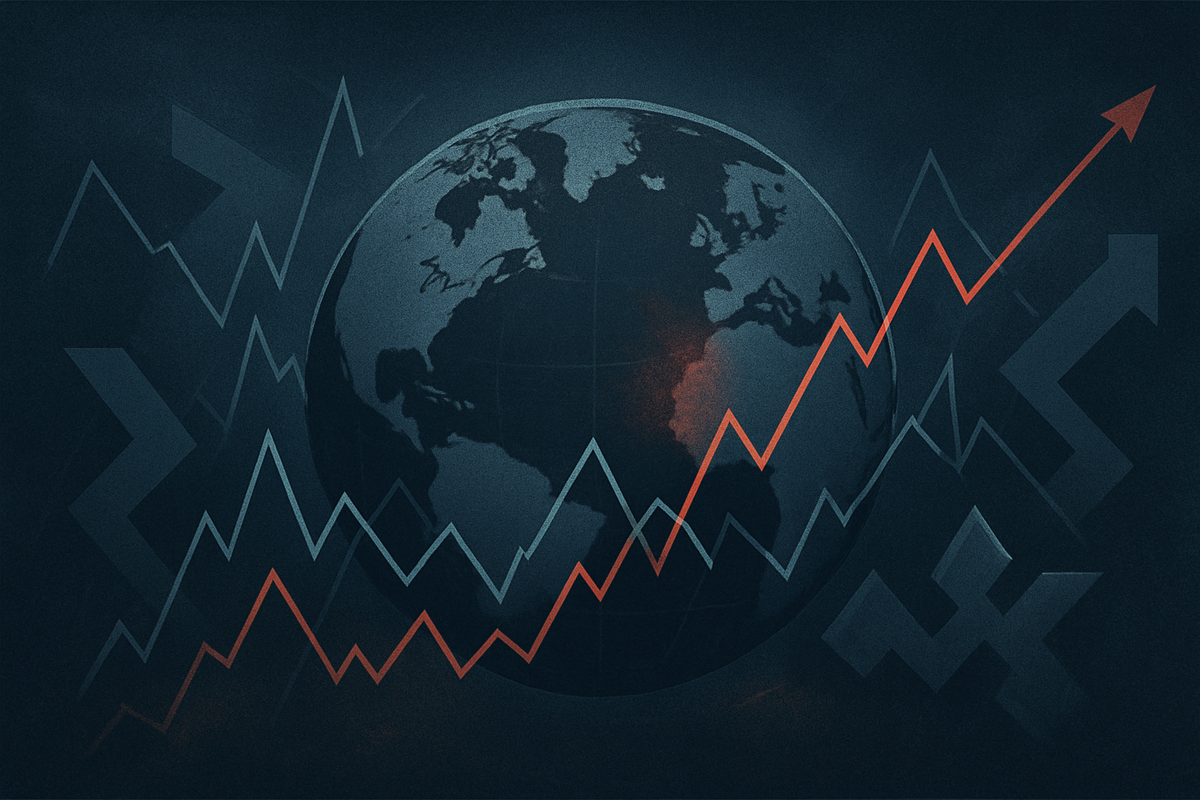
As of November 14, 2025, global financial markets are grappling with a confluence of geopolitical tensions, creating an environment of profound uncertainty and heightened risk aversion. From ongoing conflicts in Eastern Europe and the Middle East to simmering rivalries between global economic powerhouses and domestic political instability in the United States, these events are sending ripples across stock exchanges, reshaping commodity markets, and fundamentally altering investor sentiment. The once-bullish momentum-driven strategies are giving way to a more cautious and discerning approach, as market participants recalibrate their portfolios against a backdrop of persistent global instability.
The immediate implications are clear: elevated market volatility, a significant repricing of risk, and a noticeable shift in capital flows. While some sectors and assets, particularly precious metals, are experiencing a surge in demand as safe havens, others, especially those deeply embedded in global supply chains or reliant on stability, face considerable headwinds. The intricate web of international relations and domestic political landscapes is proving to be the dominant force dictating market movements, challenging traditional economic forecasts and demanding strategic foresight from investors worldwide.
A World in Flux: Detailed Coverage of Global Flashpoints
The current geopolitical landscape is defined by several flashpoints, each contributing to the pervasive market anxiety. The Russia-Ukraine War, now in its extended phase, remains a critical determinant of global energy and agricultural commodity prices. Recent developments include intensified Russian assaults on Ukraine's energy infrastructure, met with retaliatory strikes by Ukraine on Russian oil refineries and fuel depots. As of November 11, 2025, Russia maintains control over 19% of Ukrainian territory, underscoring the protracted nature of the conflict and its enduring impact on global supply chains for vital commodities like wheat and corn.
In the Middle East, the Israel-Hamas Conflict saw a fragile ceasefire brokered in October 2025, largely holding despite sporadic violations. However, the broader regional instability, exacerbated by the ongoing Iran-Israel conflict, continues to pose a significant threat to global oil and gas supplies. A particularly disruptive element has been the Houthi attacks on commercial vessels in the Red Sea since November 2023. These attacks have forced numerous shipping carriers to reroute via the Cape of Good Hope, leading to substantially increased freight and insurance costs and extended journey times. While the Houthis announced a temporary pause in attacks linked to the Gaza ceasefire, shipping operators remain highly cautious, demanding sustained assurances before fully resuming Suez Canal usage, highlighting the fragility of maritime trade routes.
Meanwhile, the US-China rivalry persists as a major source of uncertainty for global supply chains. While November 2025 has seen some easing of tensions, particularly around semiconductors, critical raw materials, and rare earths, through tariff suspensions and export control concessions until November 2026, the underlying strategic competition continues. China's growing military presence in the South China Sea and ongoing trade disputes fuel concerns of economic fragmentation and drive 'de-risking' strategies among international businesses. Experts project a 'moderate' chance of a 'high impact' cross-strait conflict over Taiwan in 2025, a scenario that could catastrophically disrupt global supply chains, especially for semiconductors.
Adding to the global instability, the United States is experiencing a federal government shutdown as of November 2025. This domestic political paralysis has triggered corporate layoffs, halted the release of crucial economic data, and disrupted essential services. Such internal instability in the world's largest economy creates systemic operational risks and further exacerbates economic uncertainties for global investors, compounding the external geopolitical pressures.
Companies in the Crosshairs: Winners and Losers in a Fractured World
The current geopolitical climate, characterized by persistent conflict and strategic competition, is creating a distinct bifurcation in corporate fortunes, with some sectors poised for significant gains while others face severe headwinds. The emphasis on national security, supply chain resilience, and regional stability is fundamentally reshaping investment landscapes and corporate strategies.
The defense sector stands out as a clear beneficiary. With global defense expenditure surpassing USD 2.6 trillion in 2024 and Europe showing the sharpest climb in spending, companies like Lockheed Martin (NYSE: LMT) are experiencing robust demand for advanced military technologies, including air defense systems and unmanned systems. Similarly, the heightened threat landscape is fueling a boom in cybersecurity firms, with the defense cybersecurity market projected to reach $46.51 billion by 2030, as nations and corporations fortify their digital defenses. In the context of the Israel-Hamas conflict, other defense contractors and US tech giants such as Microsoft (NASDAQ: MSFT), Alphabet (NASDAQ: GOOGL), Amazon (NASDAQ: AMZN), IBM (NYSE: IBM), and Palantir Technologies (NYSE: PLTR) are identified as providing crucial cloud computing, surveillance, and AI tools to military and government entities, albeit with increasing scrutiny regarding their involvement.
Conversely, companies with significant exposure to conflict zones or highly globalized supply chains are facing considerable challenges. Russian domestic industries continue to suffer from sweeping budget cuts and sanctions, with sectors like aviation and automotive seeing substantial reductions in funding. Globally, shipping companies such as Maersk (CPH: MAERSK B) and Hapag-Lloyd (ETR: HLAG) are among the hardest hit by the Red Sea disruptions, forced to reroute vessels around the Cape of Good Hope. This adds 7,000-11,000 nautical miles and 10-25 days to transit times, leading to soaring operating costs—estimated at $1 million in extra fuel per voyage—and increased insurance premiums. Executives from Maersk have even predicted potential losses of up to $3 billion if the Red Sea remains unsafe for passage until mid-2025.
The US-China tensions continue to drive a 'great rewiring of trade ties,' with significant implications for manufacturing and technology. While a temporary truce has eased some export controls on semiconductors and tariffs on critical minerals until November 2026, the underlying push for supply chain diversification benefits domestic manufacturing in the US and 'friend-shoring' countries like Mexico, Vietnam, and India. Companies like General Motors (NYSE: GM) are actively pressuring suppliers to exit China by 2027 to enhance supply chain resilience. On the losing side, US agricultural exporters, particularly soybean farmers, have historically suffered from retaliatory tariffs, with major players like Cargill, Archer Daniels Midland (NYSE: ADM), and Tyson Foods (NASDAQ: TSN) potentially losing export earnings as China shifts purchases. The semiconductor industry, despite the temporary relief, remains a battleground, with companies like Nvidia (NASDAQ: NVDA) having faced restrictions on their AI chips in China, highlighting the precarious position of tech firms caught between the two economic giants.
Finally, a hypothetical US federal government shutdown, as alluded to in the research context, would have immediate and widespread negative impacts. Government contractors would face delayed payments and halted new contracts, risking an estimated $800 million in new contracts daily. Small businesses would be cut off from crucial Small Business Administration (SBA) lending, and industries requiring federal permits or approvals would experience significant operational delays. While direct 'winners' from such an event are rare, the broader economic uncertainty would invariably lead to market volatility and reduced investor confidence across all sectors.
Wider Significance: A Paradigm Shift in Global Dynamics
The individual geopolitical flashpoints, while distinct, are coalescing into a broader paradigm shift, fundamentally altering global industry trends, international relations, and economic stability. These events collectively underscore a move towards a more fragmented and complex global order, with profound ripple effects extending far beyond their immediate epicenters.
One of the most significant overarching trends is the re-evaluation of global supply chains. The disruptions stemming from the Russia-Ukraine War, Red Sea attacks, and US-China tensions have exposed the vulnerabilities of highly optimized, just-in-time supply networks. Companies are now prioritizing resilience over efficiency, leading to accelerated efforts in 'friend-shoring,' 'nearshoring,' and the diversification of supplier bases. This strategic pivot involves building larger inventory buffers and leveraging advanced analytics to anticipate and mitigate future disruptions, marking a departure from decades of globalization-driven efficiency.
The persistent instability is also fueling an accelerated defense spending supercycle and driving innovation in military technologies. With global military expenditures surpassing USD 2.6 trillion in 2024, nations are significantly increasing their defense budgets, particularly in Europe. This surge in spending is not merely for traditional armaments but is heavily directed towards advanced technologies such as artificial intelligence, cyber capabilities, autonomous systems, and hypersonics, reshaping the global defense industry and fostering a new era of military modernization. This trend has significant implications for technology firms involved in dual-use technologies, blurring the lines between civilian and military applications.
Furthermore, energy security and the clean energy transition face complex challenges. While there's a continued push towards diversification and renewable energy deployment, geopolitical fragmentation and market disruptions pressure existing energy supplies. The Russia-Ukraine war, for instance, continues to highlight Europe's historical dependence on fossil fuels, even as the continent strives for greener alternatives. The competition for critical minerals, essential for the energy transition, is also intensifying, becoming another arena for geopolitical rivalry, particularly between the US and China.
The US-China rivalry, despite a fragile pause in some trade and tech conflicts as of November 2025, continues to drive technological nationalism and decoupling. Technology, especially semiconductors and AI, remains a central battleground. Both nations are implementing strategic export controls and investment restrictions, pushing for domestic innovation and secure supply chains in strategic technologies. This effort to build rival technological ecosystems has profound implications for global technology companies, forcing them to navigate increasingly divergent regulatory landscapes and potentially fragmenting global markets for critical components. Historically, such intense strategic competition between major powers, particularly with a strong technological dimension, draws parallels to the Cold War, but with an unprecedented level of economic interdependence now being unwound.
Finally, domestic political instability, such as the hypothetical US federal government shutdown, while internal, has wider implications for global confidence and economic predictability. Such events, while temporary, can dent the credibility of major economies on the global stage, affecting investor sentiment and potentially contributing to broader economic slowdowns. The accumulation of these diverse geopolitical shocks creates a more dangerous and complicated global era, characterized by heightened rivalries, competition for resources, and an overarching sense of fragility in the international system.
What Comes Next: Navigating a Future of Persistent Uncertainty
As global markets grapple with the present geopolitical storm, the outlook for the coming months and years suggests a landscape defined by persistent uncertainty, requiring profound strategic pivots from both nations and corporations. While some immediate tensions may see tactical de-escalations, the underlying structural challenges of great-power competition and regional instability are set to endure.
In the Russia-Ukraine War, short-term possibilities point to continued military escalation, with Russia pushing for territorial gains and Ukraine maintaining its defense with ongoing international military aid. However, the long-term outlook, extending through much of 2025, anticipates a protracted conflict that will continue to test NATO-Russia relations and impact European energy security. For businesses, this means sustained pressure on commodity prices, particularly energy and agriculture, and a continued emphasis on defense spending and cybersecurity investments.
The Israel-Hamas Conflict and its ripple effects on Red Sea disruptions offer a fragile moment of potential relief. The recent Houthi announcement of a suspension of maritime attacks and lifting of the blockade on Israeli ports, following a ceasefire, could temporarily ease pressure on global shipping. However, experts caution that this pause is conditional, and a swift return to normalcy is uncertain. Major ocean carriers may continue rerouting via the Cape of Good Hope due to persistent security risks and high marine insurance costs. This scenario suggests that while short-term shipping costs might stabilize, the long-term vulnerability of global trade routes remains, necessitating continued supply chain diversification and contingency planning.
The US-China tensions, despite a mutual easing of some trade restrictions and tariffs in November 2025, are expected to persist as a defining feature of global relations. While the short-term may see continued diplomatic engagement to manage bilateral turbulence, the long-term outlook points to an intensification of underlying strategic competition in critical technologies like semiconductors and rare earths. This 'tit-for-tat trade war' will likely exacerbate pressure on global supply chains, accelerate the trend of 'de-risking,' and force companies to align with one of two major economic blocs. Businesses must prepare for continued export controls, investment restrictions, and a push for technological self-reliance in both nations, necessitating agile import-export and investment strategies.
A recent US federal government shutdown, which ended around November 14, 2025, highlights the ongoing risk of domestic political instability. While the immediate economic costs, including a projected 1-2 percentage point reduction in fourth-quarter GDP growth, will largely be recovered, persistent impasses over federal budgets could become a recurring feature. This introduces continued uncertainty into the US economic outlook, potentially impacting global investor confidence and the timing of crucial economic data releases.
Strategically, businesses and governments must prioritize diversification and resilience. This involves localizing production, reorganizing supply chains to reduce over-reliance on single markets, and exploring secondary sourcing regions and nearshoring strategies. Proactive geopolitical risk management, integrating scenario planning with business strategy, and real-time monitoring of events will be crucial for swift adaptation. Governments will continue to implement economic security measures, including trade barriers and export restrictions, demanding that companies constantly adapt their international operations.
From a market perspective, challenges include persistent inflationary pressures, ongoing supply chain vulnerabilities, further trade fragmentation, and continued market volatility. The IMF forecasts global growth at a subdued 3.3% in 2025. However, opportunities will emerge in the defense and security sector, strategic technologies (AI, critical minerals, biotech), renewable energy and decarbonization efforts driven by the urgency for energy independence, and infrastructure investment. The trend of regionalization also creates opportunities for 'connector countries' like Mexico and Vietnam to serve as strategic manufacturing and logistics hubs. The coming period will demand a blend of caution and strategic foresight, rewarding those who can adapt swiftly to a dynamic and often unpredictable global environment.
The New Normal: Navigating a Geopolitically Driven Market
As of November 14, 2025, the global financial landscape is firmly entrenched in a "new normal" defined by an elevated and complex array of geopolitical risks. The optimism that once fueled momentum-driven rallies has given way to a pervasive sense of caution, demanding a meticulous and adaptive approach from investors and businesses alike.
Key takeaways from this period of heightened tension include the enduring disruptive power of conflicts like the Russia-Ukraine War and the Israel-Hamas conflict on energy and food supplies. The strategic rivalry between the US and China continues to fundamentally reshape global trade and technology, driving "de-risking" efforts and fostering economic fragmentation. These events, coupled with vulnerabilities in global supply chains and domestic political uncertainties, are fueling persistent inflationary pressures and shifting investor sentiment towards more defensive postures.
Moving forward, the market is assessed to remain characterized by elevated volatility and an uneven recovery. While some factors like easing inflation may offer support, they are constantly challenged by geopolitical disruptions. Equity markets, especially in emerging economies, remain vulnerable, and commodity markets, particularly oil, will be highly sensitive to regional conflicts. The long-term impact of these trends signifies a lasting shift from a purely geoeconomic order to one increasingly grounded in geopolitical risk, threatening long-term economic growth and fostering regionalized trade flows.
Investors should watch for the evolution of key conflicts, particularly their impact on commodity prices and shipping routes. Shifts in US-China relations and trade policies will continue to dictate global supply chain dynamics and technology sectors. Central bank policies and inflation data, especially from the Federal Reserve, will be crucial. Furthermore, monitoring companies' efforts towards supply chain resilience, global political stability, and the escalating cybersecurity risks will be paramount. Finally, observing sectoral rotations and the continued demand for defensive plays, stable dividend-paying stocks, and safe-haven assets like gold will provide insights into prevailing market sentiment. In this complex environment, adaptability, diversification, and proactive risk management will be the hallmarks of successful investment strategies.
This content is intended for informational purposes only and is not financial advice





